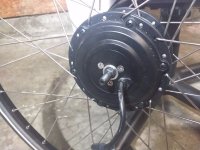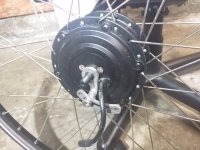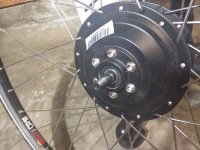bchaney
100 W
If the axle nuts on a hub motor wheel are properly torqued, will the axle ever rotate enough to make physical contact with the flats in a dropout or torque arm?
Don't get me wrong, I'm not anti-TA, just trying to figure out if they're more for insurance if they get used every ride.
I have a SWXK front hub which has a terrible axle design in which the axle flats are only on the first few mm of the axle sticking of the motor housing. This makes it hard to add washers because then you're reducing the amount of engagement between the axle flats and dropouts. Also, because of the way the housing is designed, a torque arm can only be used on one side, and the thick TA pushes the wheel off-center. If I add washers on the opposite side to center the wheel, the axle flat is not engaged with the dropout at all.
You guys think that this is a problem or should I be OK? I run the motor up to about 850w. Steel front fork.
Don't get me wrong, I'm not anti-TA, just trying to figure out if they're more for insurance if they get used every ride.
I have a SWXK front hub which has a terrible axle design in which the axle flats are only on the first few mm of the axle sticking of the motor housing. This makes it hard to add washers because then you're reducing the amount of engagement between the axle flats and dropouts. Also, because of the way the housing is designed, a torque arm can only be used on one side, and the thick TA pushes the wheel off-center. If I add washers on the opposite side to center the wheel, the axle flat is not engaged with the dropout at all.
You guys think that this is a problem or should I be OK? I run the motor up to about 850w. Steel front fork.




